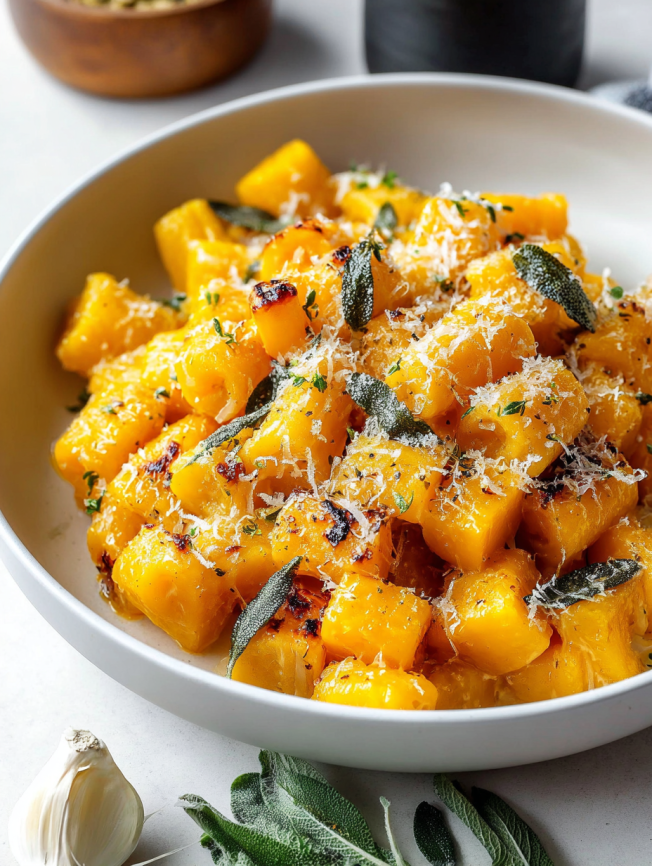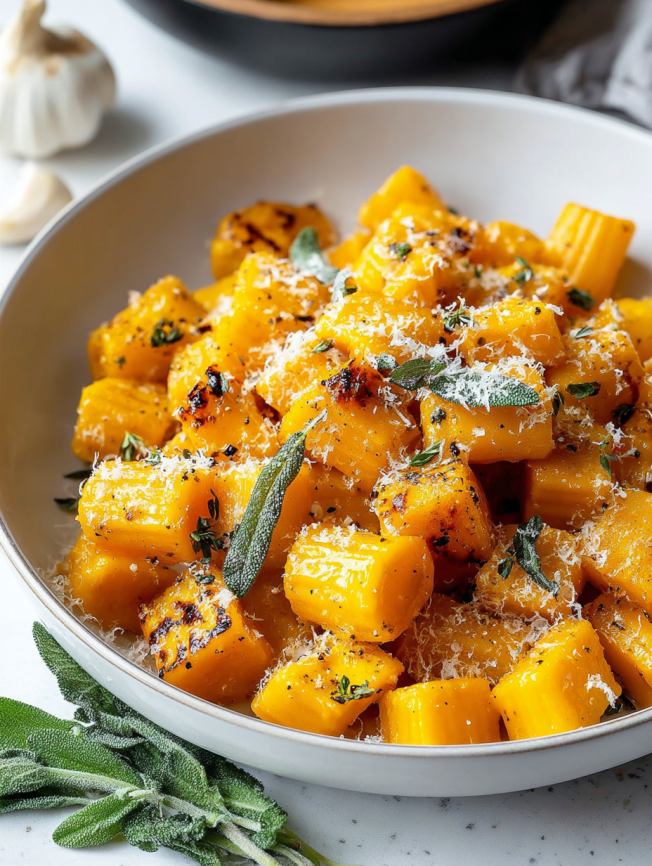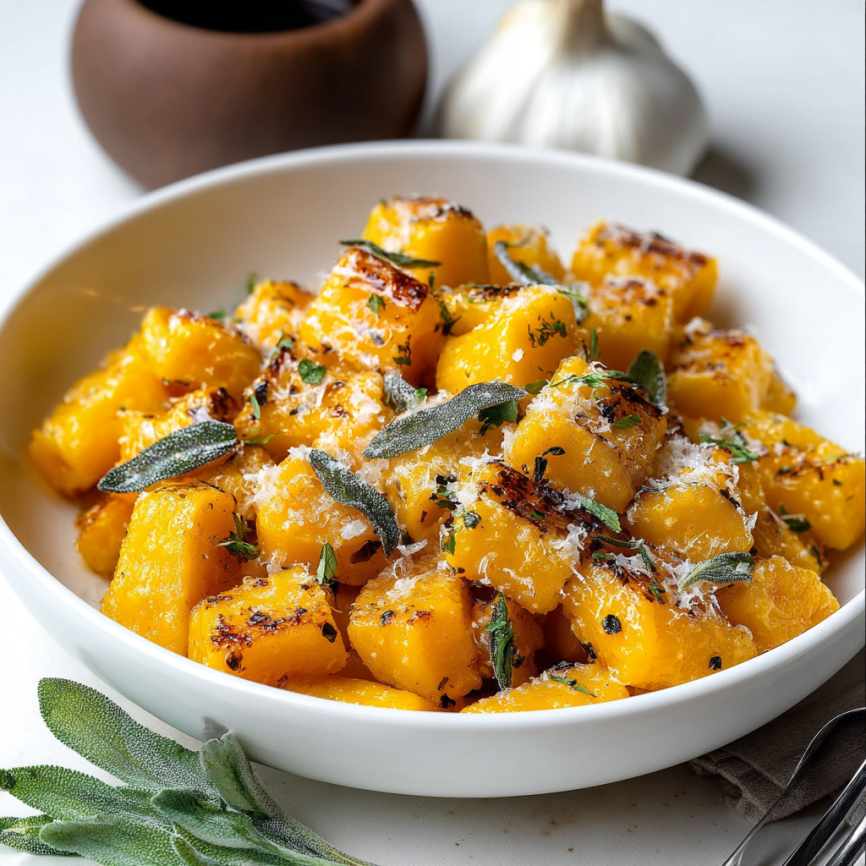A Happy Kitchen Accident That Became Family Legend
Three years ago, I was preparing my usual butternut squash soup when my teenage son wandered into the kitchen asking about dinner. With leftover roasted squash cooling on the counter and a box of penne staring at me from the pantry, inspiration struck. Instead of making soup, what if I turned that golden, caramelized squash into a pasta sauce? An hour later, we were all gathered around the table, twirling forks through the silkiest, most flavorful pasta we’d ever tasted. That spontaneous experiment became our most requested fall dinner, and now friends beg for the recipe every September. Sometimes the best dishes come from happy accidents and hungry teenagers!
Why This Pasta Will Become Your Autumn Obsession
Naturally Creamy Without Heavy Cream
The magic happens when roasted butternut squash transforms into a velvety sauce that rivals any cream-based pasta. The caramelization process concentrates the squash’s natural sugars, creating depth and richness that feels indulgent while being surprisingly light.
Perfect Balance of Sweet and Savory
Unlike overly sweet autumn dishes, this pasta achieves harmony through the earthy sage, aromatic garlic, and sharp Parmesan. Each element complements the others, creating a sophisticated flavor profile that appeals to both adults and children.
Weeknight Simple, Weekend Elegant
This recipe requires just one pan for the sauce and basic cooking techniques, making it accessible for busy weeknights. However, the restaurant-quality results make it impressive enough for dinner parties or holiday entertaining.
Nutritionally Satisfying
Butternut squash provides vitamin A, fiber, and potassium, while the pasta offers complex carbohydrates for sustained energy. Additionally, this dish leaves you feeling satisfied without the heaviness of traditional cream sauces.
Essential Ingredients
For the Roasted Squash Base
- 1 medium butternut squash (about 2-3 pounds), peeled and cubed
- 1 tablespoon olive oil, plus extra for roasting
- Salt and freshly ground black pepper
For the Aromatic Sauce
- 1 small onion, finely chopped
- 3 cloves garlic, minced
- 1 teaspoon chopped fresh sage (or 1/2 teaspoon dried)
- 1/2 teaspoon red pepper flakes (optional, for gentle heat)
For the Creamy Finish
- 1/2 cup vegetable broth
- 1/2 cup milk or cream (dairy or non-dairy alternatives work beautifully)
- 1/4 cup grated Parmesan cheese, plus extra for serving
- 10 oz pasta of choice (penne, rigatoni, or spaghetti work best)
For the Perfect Garnish
- Fresh parsley or basil, chopped
- Additional Parmesan cheese
- Toasted pine nuts (optional)
Serving Suggestions
This recipe serves 4 generously and pairs wonderfully with a crisp arugula salad dressed in lemon vinaigrette, crusty sourdough bread, or roasted Brussels sprouts with bacon.
Step-by-Step Instructions
Creating the Roasted Foundation
- Prepare for roasting: Preheat your oven to 400°F (200°C) and line a large baking sheet with parchment paper. This high temperature ensures proper caramelization of the squash edges.
- Season the squash: Toss the cubed butternut squash with a drizzle of olive oil, salt, and pepper until evenly coated. Spread in a single layer on the prepared baking sheet, ensuring pieces don’t overlap.
- Roast to perfection: Bake for 25-30 minutes, until the squash is fork-tender and develops golden, caramelized edges. This roasting process is crucial for developing the sauce’s deep, sweet flavor.
Preparing the Pasta
- Cook the pasta: While the squash roasts, bring a large pot of salted water to boil. Cook your chosen pasta according to package directions until al dente. Before draining, reserve 1/2 cup of the starchy pasta water for later use.
Building the Sauce
- Sauté the aromatics: In a large skillet over medium heat, warm the olive oil. Add the finely chopped onion and sauté for about 4 minutes until it becomes translucent and fragrant.
- Add the flavor builders: Incorporate the minced garlic, fresh sage, and red pepper flakes (if using). Sauté for just 1 minute until aromatic, being careful not to brown the garlic.
- Combine and simmer: Add the roasted butternut squash, vegetable broth, and milk or cream to the skillet. Bring to a gentle simmer and cook for 5 minutes, allowing the flavors to meld together.
Creating Silky Perfection
- Blend to smoothness: Using an immersion blender directly in the skillet, purée the mixture until completely smooth. Alternatively, carefully transfer the hot mixture to a regular blender and process until velvety, then return to the skillet.
- Finish with cheese: Stir in the Parmesan cheese until melted and incorporated. Taste and adjust seasoning with salt and pepper as needed. If the sauce seems too thick, thin it with reserved pasta water until you reach the desired consistency.
Final Assembly
- Marry pasta and sauce: Add the drained pasta to the skillet with the sauce. Toss gently but thoroughly to coat every piece, cooking together for 2-3 minutes to allow the pasta to absorb some of the sauce.
- Serve with style: Transfer to warmed serving bowls and garnish with additional Parmesan cheese, fresh herbs, and a crack of black pepper.

Creative Serving Ideas
Restaurant-Style Presentation
Serve in shallow, warmed bowls with a artistic sprinkle of freshly grated Parmesan and a few whole sage leaves fried in butter until crispy. Add a drizzle of good olive oil for glossy appeal.
Family-Style Comfort
Present the pasta in a large, beautiful serving bowl at the center of the table with small bowls of extra cheese, red pepper flakes, and fresh herbs so everyone can customize their portions.
Delicious Recipe Variations
Protein-Packed Version
Add crispy pancetta or prosciutto during the onion sautéing step for smoky depth. Alternatively, stir in cooked Italian sausage crumbles for a heartier meal that satisfies meat lovers.
Nutty Autumn Delight
Toast pine nuts or chopped walnuts and sprinkle over the finished dish for added texture and richness. The nuts complement the squash’s natural nuttiness beautifully.
Vegan-Friendly Adaptation
Replace the milk with full-fat coconut milk or cashew cream, and substitute nutritional yeast for the Parmesan cheese. The result is equally creamy and satisfying.
Spiced Winter Version
Add a pinch of cinnamon and nutmeg to the sauce for warming spice notes. This variation pairs especially well with whole wheat pasta and a sprinkle of toasted pumpkin seeds.
Make-Ahead and Storage Tips
Sauce Preparation
The butternut squash sauce can be made up to 3 days in advance and stored in the refrigerator. Reheat gently on the stovetop, adding a splash of broth or milk to restore the creamy consistency.
Freezing Guidelines
The sauce freezes beautifully for up to 3 months. Freeze in portion-sized containers and thaw overnight before reheating. Fresh pasta should be cooked separately when ready to serve.
Reheating Best Practices
Reheat leftover pasta gently in a skillet with a splash of milk or broth, stirring frequently to prevent sticking. The dish tastes best when served immediately after reheating.
Important Notes
Squash Selection Tips
Choose butternut squash that feels heavy for its size with hard, tan skin free of soft spots or blemishes. The neck portion contains the most usable flesh, so look for squashes with proportionally longer necks.
Pasta Shape Considerations
Short, tube-shaped pastas like penne or rigatoni hold the sauce beautifully in their ridges and hollows. However, long pasta shapes like fettuccine or pappardelle also work wonderfully for elegant presentations.
Achieving Perfect Consistency
The sauce should coat the pasta without being too thick or too thin. Use pasta water gradually to achieve the ideal consistency – it should cling to the pasta but not be gluey.

Frequently Asked Questions
Can I use pre-cut butternut squash to save time? Absolutely! Pre-cut butternut squash from the grocery store works perfectly and saves significant prep time. Just ensure the pieces are uniform in size for even roasting and check that they look fresh without dry edges.
What can I substitute for fresh sage? Dried sage works well at half the quantity, or you can use fresh thyme or rosemary for different but equally delicious flavor profiles. Even dried Italian seasoning makes a suitable substitute in a pinch.
How do I make this dish dairy-free? Replace the milk with unsweetened oat milk, cashew cream, or full-fat coconut milk. For the Parmesan, use nutritional yeast or a good-quality dairy-free Parmesan alternative.
Can I make this gluten-free? Yes! Simply substitute your favorite gluten-free pasta. Rice-based or chickpea pasta work particularly well with this sauce, though cooking times may vary from the package directions.
What if my sauce turns out too sweet? Balance excessive sweetness by adding a splash of white wine vinegar or lemon juice. You can also increase the savory elements by adding more garlic, sage, or a pinch of salt.
How do I prevent the garlic from burning? Keep the heat at medium and add the garlic after the onions have had time to cook. Garlic burns quickly and becomes bitter, so sauté it for just one minute until fragrant.
Can I add vegetables to this pasta? Definitely! Roasted Brussels sprouts, sautéed mushrooms, or wilted spinach all complement the butternut squash beautifully. Add heartier vegetables during the roasting step and delicate greens at the very end.
What’s the best way to reheat leftovers? Reheat gently in a skillet over medium-low heat with a splash of milk or broth. Stir frequently and avoid high heat, which can cause the sauce to separate or the pasta to become mushy.
Prep Time: 10 minutes | Cooking Time: 35 minutes | Total Time: 45 minutes
Calories: 410 kcal | Servings: 4 servings

